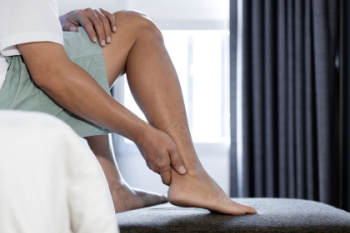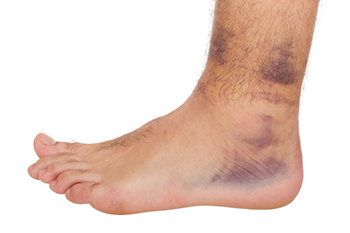Connect With Us
Blog
Items filtered by date: August 2024
Managng Achilles Tendon Injuries

An Achilles tendon injury can be painful and limiting, affecting your ability to walk, run, or engage in daily activities. This strong tendon connects the calf muscles to the heel and plays a vital role in movements like walking, jumping, and climbing stairs. Achilles tendinitis, often caused by overuse, results in stiffness and pain in the back of the heel, which can worsen with activity. If left untreated, this condition can progress to Achilles tendinosis, leading to further degeneration of the tendon. In severe cases, an Achilles tendon rupture may occur, causing sudden, sharp pain and making it difficult to walk. While treatment options vary based on the severity of the Achilles tendon injury, a podiatrist can provide both non-surgical and surgical solutions tailored to your needs. These may include targeted exercises, custom orthotics, or surgery to repair a ruptured tendon. If you have incurred an Achilles tendon injury, it is suggested that you schedule an appointment with a podiatrist for a diagnosis and treatment.
Achilles tendon injuries need immediate attention to avoid future complications. If you have any concerns, contact one of our doctors of Advanced Podiatry. Our doctors can provide the care you need to keep you pain-free and on your feet.
What Is the Achilles Tendon?
The Achilles tendon is a tendon that connects the lower leg muscles and calf to the heel of the foot. It is the strongest tendon in the human body and is essential for making movement possible. Because this tendon is such an integral part of the body, any injuries to it can create immense difficulties and should immediately be presented to a doctor.
What Are the Symptoms of an Achilles Tendon Injury?
There are various types of injuries that can affect the Achilles tendon. The two most common injuries are Achilles tendinitis and ruptures of the tendon.
Achilles Tendinitis Symptoms
- Inflammation
- Dull to severe pain
- Increased blood flow to the tendon
- Thickening of the tendon
Rupture Symptoms
- Extreme pain and swelling in the foot
- Total immobility
Treatment and Prevention
Achilles tendon injuries are diagnosed by a thorough physical evaluation, which can include an MRI. Treatment involves rest, physical therapy, and in some cases, surgery. However, various preventative measures can be taken to avoid these injuries, such as:
- Thorough stretching of the tendon before and after exercise
- Strengthening exercises like calf raises, squats, leg curls, leg extensions, leg raises, lunges, and leg presses
If you have any questions please feel free to contact our offices located in Needham, Norwood, and Hanover, MA . We offer the newest diagnostic tools and technology to treat your foot and ankle needs.
Three Types of Ankle Sprains and Their Causes

Ankle sprains vary in severity and are classified into three grades. A Grade 1 sprain is mild, involving slight stretching of the ligaments with minimal damage. It typically results from a minor twist or roll of the ankle, often seen in everyday activities. A Grade 2 sprain is more severe, with partial tearing of the ligaments. This type usually occurs from a more significant impact or an awkward landing, leading to moderate pain and swelling. The most serious, a Grade 3 sprain, involves a complete tear of the ligament. This severe injury often results from high-impact events or sudden, forceful movements, causing intense pain, swelling, and instability. Each grade requires specific treatment and rehabilitation to ensure proper recovery and prevent future issues. If you have suffered an ankle sprain, it is suggested that you visit a podiatrist who can determine what the grade is, and offer appropriate treatment options.
Although ankle sprains are common, they aren’t always minor injuries. If you need your ankle injury looked at, contact one of our doctors from Advanced Podiatry. Our doctors can provide the care you need to keep you pain-free and on your feet.
How Does an Ankle Sprain Occur?
Ankle sprains are the result of a tear in the ligaments within the ankle. These injuries may happen when you make a rapid shifting movement while your foot is planted. A less common way to sprain your ankle is when your ankle rolls inward while your foot turns outward.
What Are the Symptoms?
- Pain at the sight of the tear
- Bruising/Swelling
- Ankle area is tender to touch
- In severe cases, may hear/feel something tear
- Skin discoloration
Preventing a Sprain
- Wearing appropriate shoes for the occasion
- Stretching before exercises and sports
- Knowing your limits
Treatment of a Sprain
In many cases, the RICE method (Rest, Ice, Compression, and Elevate) is used to treat ankle sprains. However, you should see a podiatrist to see which treatment option would work best with your injury. In severe cases, surgery may be required.
It is important to ask your doctor about rehab options after you receive treatment for your injury. Stretching, strength training, and balance exercises may help the ankle heal while also preventing further injury.
If you have any questions, please feel free to contact our offices located in Needham, Norwood, and Hanover, MA . We offer the newest diagnostic and treatment technologies for all your foot care needs.
Gout and the Role of Uric Acid

Gout is a form of arthritis that causes flare-ups of sudden, severe pain, redness, and swelling in the affected joints, commonly starting in the big toe. This condition occurs when uric acid, a waste product produced from the breakdown of purines found in certain foods, accumulates in the blood. When uric acid levels become excessively high, it can form sharp, needle-like crystals that deposit in the joints, leading to intense pain and inflammation. The causes of gout include a combination of genetic factors, diet, and lifestyle choices. Consuming foods rich in purines, such as red meat and seafood, excessive alcohol intake, and dehydration can increase uric acid levels. Managing gout involves medication to lower uric acid levels, dietary changes, and maintaining a healthy lifestyle. If you have developed gout, it is strongly suggested that you are under the care of a podiatrist who can effectively treat and help you manage it.
Gout is a foot condition that requires certain treatment and care. If you are seeking treatment, contact one of our doctors from Advanced Podiatry. Our doctors will treat your foot and ankle needs.
What Is Gout?
Gout is a type of arthritis caused by a buildup of uric acid in the bloodstream. It often develops in the foot, especially the big toe area, although it can manifest in other parts of the body as well. Gout can make walking and standing very painful and is especially common in diabetics and the obese.
People typically get gout because of a poor diet. Genetic predisposition is also a factor. The children of parents who have had gout frequently have a chance of developing it themselves.
Gout can easily be identified by redness and inflammation of the big toe and the surrounding areas of the foot. Other symptoms include extreme fatigue, joint pain, and running high fevers. Sometimes corticosteroid drugs can be prescribed to treat gout, but the best way to combat this disease is to get more exercise and eat a better diet.
If you have any questions, please feel free to contact our offices located in Needham, Norwood, and Hanover, MA . We offer the newest diagnostic and treatment technologies for all your foot care needs.
Get Professional Care for a Broken Foot or Ankle
Side of the Foot Pain
 Side foot pain, often referred to as lateral foot pain, can stem from various causes, including overuse injuries, stress fractures, or conditions such as peroneal tendonitis. This discomfort can affect daily activities, leading to issues with walking or standing. Common causes can include wearing ill-fitting shoes, excessive physical activity, or trauma. Conditions like arthritis, cuboid syndrome, or bunions can also contribute to lateral foot pain. Symptoms may include swelling, tenderness, and difficulty bearing weight on the affected foot. Treatment for side of foot pain focuses on reducing inflammation and promoting healing. Resting the foot and avoiding activities that increase the pain is essential. Mild pain relievers can alleviate discomfort. Wearing supportive footwear or using custom orthotics can provide additional support and correct any biomechanical issues. If you have lateral foot pain and it persists or worsens, it is suggested that you consult a podiatrist.
Side foot pain, often referred to as lateral foot pain, can stem from various causes, including overuse injuries, stress fractures, or conditions such as peroneal tendonitis. This discomfort can affect daily activities, leading to issues with walking or standing. Common causes can include wearing ill-fitting shoes, excessive physical activity, or trauma. Conditions like arthritis, cuboid syndrome, or bunions can also contribute to lateral foot pain. Symptoms may include swelling, tenderness, and difficulty bearing weight on the affected foot. Treatment for side of foot pain focuses on reducing inflammation and promoting healing. Resting the foot and avoiding activities that increase the pain is essential. Mild pain relievers can alleviate discomfort. Wearing supportive footwear or using custom orthotics can provide additional support and correct any biomechanical issues. If you have lateral foot pain and it persists or worsens, it is suggested that you consult a podiatrist.
Foot Pain
Foot pain can be extremely painful and debilitating. If you have a foot pain, consult with one of our doctors from Advanced Podiatry. Our doctors will assess your condition and provide you with quality foot and ankle treatment.
Causes
Foot pain is a very broad condition that could be caused by one or more ailments. The most common include:
- Bunions
- Hammertoes
- Plantar Fasciitis
- Bone Spurs
- Corns
- Tarsal Tunnel Syndrome
- Ingrown Toenails
- Arthritis (such as Gout, Rheumatoid, and Osteoarthritis)
- Flat Feet
- Injury (from stress fractures, broken toe, foot, ankle, Achilles tendon ruptures, and sprains)
- And more
Diagnosis
To figure out the cause of foot pain, podiatrists utilize several different methods. This can range from simple visual inspections and sensation tests to X-rays and MRI scans. Prior medical history, family medical history, and any recent physical traumatic events will all be taken into consideration for a proper diagnosis.
Treatment
Treatment depends upon the cause of the foot pain. Whether it is resting, staying off the foot, or having surgery; podiatrists have a number of treatment options available for foot pain.
If you have any questions, please feel free to contact our offices located in Needham, Norwood, and Hanover, MA . We offer the newest diagnostic and treatment technologies for all your foot care needs.

